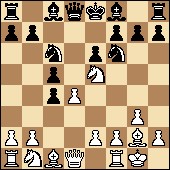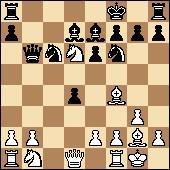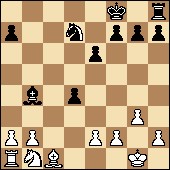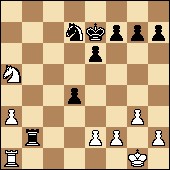Who would have thought, before this tournament, or any tournament, that it would be possible to describe Vladimir Kramnik and Peter Leko with such a word? But it’s true: in Dortmund 2010 they are both far out of contention.
Barring an unforeseen debacle, it looks as if Ruslan Ponomariov is going to be your winner. With a win over Arkadij Naiditsch today, Ponomariov took a commanding one-point lead with 5½ points, over Le Quang Liem and Shakhriyar Mamedyarov who have 4½ each. Kramnik is in fourth place with 4 points out of 8, and Leko is bringing up the rear with 2½. (Fifth is Naiditsch with 3.)
Today I bring you my translation of GM Sergey Shipov’s commentary on the game between Leko and Kramnik. As usual, you can play over the moves at www.crestbook.com, where Shipov’s original Russian commentary can be found. Just look for the “NEW” symbol on the home page, or if you prefer, go directly to this page.
Tomorrow, Shipov will comment on the ninth-round game between Mamedyarov and Ponomariov, and the translation will be at www.chessintranslation.com.
Now, I turn it over to Shipov. — DM
Good day, esteemed fans and connoisseurs of chess! Grandmaster Sergey Shipov offers for your attention the eighth round of the competition in Dortmund. Today I am closing a circle by showing the last-place participant in the tournament, Peter Leko, in action. I can’t even remember the last time I saw the Hungarian grandmaster in such a lamentable condition. And it’s fairly hard to understand why failure is stalking him so mercilessly! Peter is trying, and doing everything right, scientifically, but the ball stubbornly refuses to go in the goal, while everything is going into his own goal. In general, just a terrible run of bad luck. But the real reasons for his debacle probably have something to do with psychology … Leko has been playing in supertournaments since childhood. He reached the elite in record time, and has already been appearing in this traveling circus-Big Top for almost two decades, going from one tournament to the next. Without a break. In my opinion, Peter is simply tired — morally and psychologically. Such monotonous work, without any serious breaks, without any changes in lifestyle, without any shake-up or relaxation is enough to crush the life out of even a strong man in the prime of his career. It’s hard for me to give advice from the side, but I think that it’s time for the noteworthy Hungarian grandmaster to think outside the box. Let’s say, decline a few tournaments, study yoga, write a couple books, take on some students, travel around the world as an ordinary tourist. Take a broader look on life! And at the same time, to build up his chess appetite so that he can come back rejuvenated to supertournaments.
But for now … for now he is playing White against Kramnik, whom he was unable to beat in the first half of the tournament as Black with an extra piece. Let’s see if Leko manages to squeeze even a few drops out of an already squeezed lemon …
Leko, P. — Kramnik, V.
Dortmund 2010 (round 8), 7/23/2010
1. d4 …
The time of endless duels in Petroff’s Defense has passed.
1. … Nf6 2. c4 e6
Kramnik’s pause before making this move gave me a chance to dream … It would be very interesting to see how Kramnik would handle the Grunfeld Defense or even, darn it, the King’s Indian!
3. Nf3 d5 4. g3 …
But instead of that we see the same old scenery that has already bored us to tears — the Catalan opening.
4. … dc
An intriguing move. It looks as if Vladimir is in a fighting mood today: he is planning to take his old colleague unawares while the latter is clearly not in good form and is playing with a background of negative emotions. Against Le, Kramnik played the more careful variation with 4. … Be7.
5. Bg2 c5
Peter has already started to think — apparently he did not expect to see this position over the board. His morning preparation turned out to be useless… One more bitter pill for someone who has already had to swallow many of them!
6. O-O Nc6
Now Leko, like the rich man in the fable, has a choice of three paths. If you go to the left, you lose a pawn. If you go the the right, again you lose a pawn, and if you go straight, you’ll end up with a quick draw. I’m curious whether Leko and his trainers have managed to study the memorable Kramnik-Naiditsch game from the fifth round. Maybe he should take the path that was blazed by today’s opponent?
7. Ne5 …
Boldly played! A pleasant move for all the viewers — we will get to see some new variations. In the aforementioned game, Kramnik chose 7. Qa4. Also, 7. dc is sometimes seen, and even 7. Na3.
7. … Bd7
Compulsory modesty. 7. … Nxd4? is a mistake because of 8. e3! Nf5 9. Qxd8+ Kxd8 10. Nxf7+, and Black loses a rook. Also, 7. … Nxe5 does not bring any joy after 8. de Qxd1 9. Rxd1 Nd5 10. Na3! threatening unpleasant raids by the White knight. For example, to d6.
8. Nxc4 …
A surprise. This move became popular in the beginning of the 1980s. If you want to familiarize yourself with the basic ideas, I recommend the games of Oleg Romanishin. Experienced Catalan players, for the most part, play 8. Na3 with the idea of taking on c4 with the other knight.
8. … cd
Kramnik, as usual, gives the impression that his opponent’s unexpected choice does not bother him in the least. He played his answer instantly!
9. Bf4 …
But now he will probably have to think a bit. White is threatening to sink his knight on d6. Let’s take a timely glance at the clock: 1:28 – 1:36.
9. … Be7
The contemporary treatment of the variation. Black is prepared to give away the pawn at b7 and lose the right to castle — anything you want, except for trading the bishop on d6!
Previous generations played 9. … Nd5 10. Nd6+ Bxd6 11. Bxd6 Nde7 12. Nd2 (12. Qb3 was also sometimes played) 12. … O-O 13. Qb3 Bc8 14. Ba3 (or 14. Nc4) 14. … Re8 15. Rac1 Nf5 16. Ne4 and White has terrific pressure for the pawn, O.Romanishin – S. Smagin, Essen 2001.
10. Nd6+ Kf8
Exactly! The bishop did not move to e7 in order to take on d6, losing a whole tempo.
11. Nxb7 …
Going away in order to return.
11. … Qb6
Black uses the time to mobilize his forces.
12. Nd6 …
12. … Qc5
All of this is theory, my friends. The players have not really even begun to think seriously! They are only remembering… However, for Leko this process is twice as difficult and twice as slow: 1:16 – 1:33. And right now he has to contend with the terrible temptation to end the game with a dishonorable repetition of moves: 13. Nb7 Qb5 14. Nd6 Qc5 15. Nb7 and so on.
Too dangerous for Black was 12. … Qxb2 13. Nd2 — an open war will soon expose the impossibility of bringing the rook on h8 into battle. The amateur move 12. … e5? does not win, but on the contrary leads to a disaster: 13. Nc4 Qc5 14. Nxe5! Nxe5 15. Bxa8 etc.
13. Qb3 …
Attaboy, Peter. He did not give in! And he made up a novelty over the board. He baits Black with the knight on d6. In response White will move the rook to c1, and … we’ll see everything in detail now.
The minuses of the modest retreat 13. Ne4 were made evident in the game V. Loginov – P. Anisimov, St. Petersburg 2006, in which after 13. … Nxe4 14. Bxe4 Black unexpectedly charged forward with his pawns: 14. … g5! 15. Bc1 f5 16. Bg2 Rc8 17. e3 Bf6 and Black has a substantial advantage. In my opinion, the root of all evil in White’s position is apparent to the unaided eye — almost all of his soldiers are standing on the first rank.
Interesting complications took place in the game B. Gelfand – M. Adams, Yerevan 2008: 13. b4 Qxb4 14. a3 Qc5 15. Nd2 e5 (15. … Bxd6 16. Nb3!) and White accomplished absolutely nothing except getting some chances to save the game. [Translator’s note: I omitted some moves here that you can play over at the site.]
13. … Bxd6
Gathering his courage, Vladimir takes the principled route. Black still had many chances to go wrong. We’ll start with the amateur blunder, 13. … e5? 14. Qxf7 mate! A little bit better is 13. … Rb8 14. Nb7! and White wins an exchange. Also unsatisfactory is 13. … Nd5 because of 14. Rc1 Qa5 15. Nc4 Qa6 16. Ne5! with dangerous pressure for White.
14. Rc1 …
Black cannot advantageously sacrifice his queen. She will have to step aside.
14. … Qb4 15. Bxc6 …
Beginning a series of exchanges. It’s not so easy to evaluate the endgames that arise. There are nuances… For example, in case Black trades on b3 the rook on a1 will enter the battle quite decisively. Consequently, Black will have to refrain. The position on the clock has nearly equalized: 1:01 – 1:06.
15. … Rc8
The most accurate. There is no reason to allow White’s rook to c6. Better to exchange it and at the same time banish the f4 bishop back home to c1.
16. Qxb4 Bxb4 17. Bxd7 …
I’m not sure that this is the best way. The simplest and most natural? Yes. But 17. Rc4 was also worthy of attention, with the idea of leaving the bishops in a fighting position after 17. … Be7 18. Bb5! A second interesting direction, 17. a3, would most likely lead to a transposition of moves.
17. … Rxc1+ 18. Bxc1 Nxd7
It’s time to evaluate the contours of the endgame. White has the prospect of forming a passed pawn on the queenside. But for now that is only on paper — his horrific disadvantage in development keeps him from putting his plans into practice. Nevertheless, the pawn break a2-a3 and b2-b4 begs to be played. And the pieces will follow after. In any case, Black’s advantage in the center should guarantee him reasonable counterplay.
19. Bd2 …
I am forced to agree. And the long, tormented meditation of Kramnik speaks to the fact that Black has some problems. The time is 0:56 – 0:47!
The move 19. a3 does not transpose after all to the variation 17. a3!, because Black is not obliged to retreat the bishop to e7. He can play 19. … Bd6!, saving e7 for his king and, consequently bringing the rook into battle more quickly. That’s not what the doctor ordered!
19. … a5
It took a great deal of effort for Vladimir to arrive at this move. He is quite responsible after all. But at the same time, good.
The exchange at d2, of course, cannot be taken seriously. Why help the opponent develop his pieces? But a retreat of the bishop also has its minuses. It’s obviously bad to go to e7, since he eventually has to extract his king from f8. On 18. … Bc5 White would add wood to the fire with 20. b4 — a pawn advance is, after all, part of his plan. Finally, on 19. … Bd6 would follow 20. Na3!, and White would continue to gain tempi on the queenside.
20. a3 …
Once again, I agree. 20. Bxb4+ ab 21. a3 ba 22. Nxa3 Ke7 does not give White any advantage — the pawn at b2 is not dangerous to Black.
20. … Bxd2 21. Nxd2 …
What is the point of the inclusion of the moves … a7-a5 and a2-a3? Now the pawn on b2 is very vulnerable. It seems we are in for more exchanges and equalization …
21. … Ke7
His ancient dream has come true. 21. … a4 is in no way better. For example, 22. Rc1 Ke7 23. Rc6! Rb8 24. Nc4 with a small advantage for White.
22. Nb3 …
Leko hurries to take advantage of the tarrying of Black’s rook on h8.
22. … Rb8 23. Nxa5 Rxb2
And so White has obtained a protected passed pawn. Not only that, it has a powerful producer on a1 that is ready to promote it. The knight must get out of the way, but as it steps aside it will destroy the potentially dangerous pawn on d4… The clock does not raise any alarms: 0:40 – 0:36.
24. Nc6+ Kf6
The move 24. … Kd6 would lead to a real, not temporary loss of a pawn after 25. Nxd4, because 25. … e5 runs into 26. Nf5+!
25. а4 …
The move of a serious warrior who is sure of his abilities. Peter is allowing the move … e6-e5, fortifying the d4 pawn. He places the emphasis on his frisky passed pawn. The other, quieter continuation 25. Nxd4 e5 26. Nc6 Rxe2 27. a4 promised White some chances for a win. Mainly practical chances.
25. … Rxe2
The continuation 25. … e5 26. a5 Rxe2 27. a6 is not for the faint of heart. In fact, I think it’s a bust. The White pawn is too close to its goal.
26. Nxd4 …
It’s time. Here 26. a5 would not work because of 26. … d3! 27. a6 d2 28. Kf1 Re4 29. a7 Nb6, and White remains down a pawn in all variations.
26. … Rd2
Here every tempo is valuable. Black must either place a firm barrier in the path of the White passed pawn, or create counterplay. Or both! But that’s not realistic.
27. Nb5 …
The next difficult choice. The White knight has no unquestionably good itinerary. For example, if 27. Nf3 Rd6 28. a5 Nc5 Black has not only stopped the pawn but is actually threatening to win it. And in case of 27. Nb3 Rd3 White’s rook is forced to leave the righteous path with 28. Rb1.
27. … Rd5
Simple and strong. He simply does not allow White to move the pawn. Weaker would be 27. … Rb2 28. Nc3 Rb3 29. Ne4+, and the pawn on a4 can soon go on its merry way again.
28. Rb1 …
A change of guard for the knight.
28. … Rd2
An attempt to replace the White rook behind the passed pawn.
29. Ra1 …
An attractive, logical repetition of moves. What could be more enticing for a pair of tired warriors?
29. … Rd5
Thoughts of dinner are starting to distract me from my work …
30. Rb1 …
And there is not very much time left on the clocks: 0:14 – 0:16.
30. … Rd2 31. Ra1 Rd5 ½-½
Time to stop running in circles.
Aside from the completely predictable result, the game was interesting and substantive. Leko played the opening creatively, and in my opinion had chances for success. White needs to analyze the position around move 17 seriously. Not hastily and very deeply. Perhaps one of my moves given in the notes might give White a real advantage. Whatever, the future will tell.
The draw preserves the current standings of the adversaries in the tournament. Kramnik is in the middle of the crosstable, and Leko at the very bottom… And on that note, I, grandmaster Sergey Shipov, will end my reportage. Thanks for your attention, and I’ll see you tomorrow.







